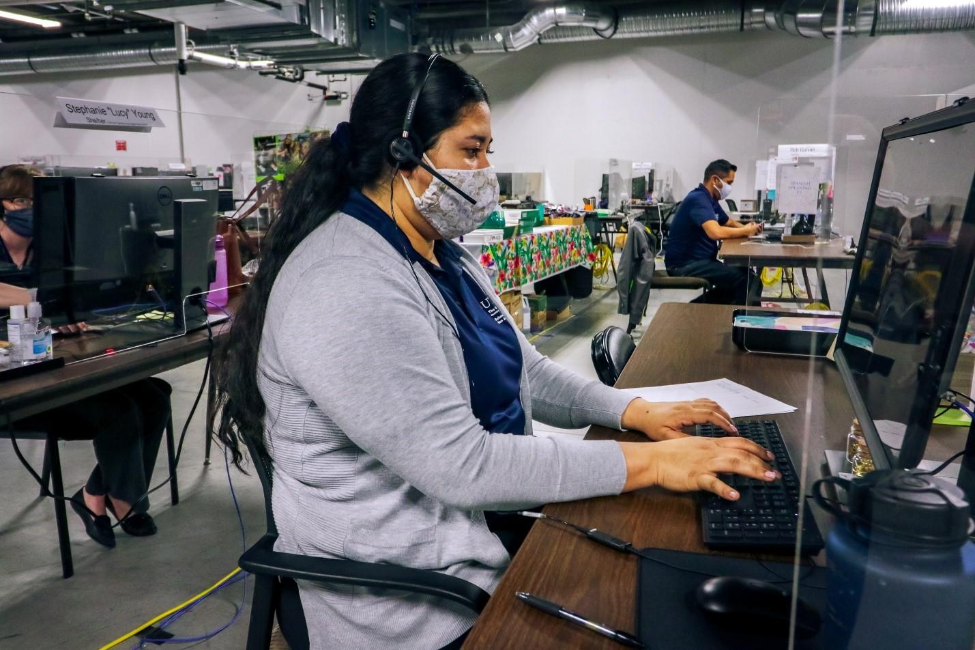Landmark COVID-19 contact tracing project reached out to thousands of San Antonio residents


After two years and hundreds of thousands of calls to residents, UTHealth Houston School of Public Health wrapped up its COVID-19 contact tracing program in San Antonio at the end of September. The project was a partnership with the City of San Antonio’s Metropolitan Health department. Metro Health contracted with the school to develop the scripts and protocols; hire and train case investigators, also known as contact tracers; and run an extensive operation that ultimately continued for much longer than early predictions and reached hundreds of thousands of Bexar County residents.
Jack Tsai, PhD, took over as dean of the school’s 40-year-old San Antonio campus in 2020 right before the pandemic began.
“Over the past two years, we have proudly worked alongside Metro Health to lead COVID-19 contact tracing for residents of the City of San Antonio,” Tsai said. “As a city, we were able to persevere together through the largest pandemic of our time.”
Anita Kurian, MBBS, MPH, DrPH, deputy director of Metro Health, said she chose to work with UTHealth Houston School of Public Health for the project so that the city would have a group of qualified contact tracers with public health backgrounds.
“I was 100% confident that this partnership would be very productive and effective in assisting us with this response to the pandemic,” Kurian said. “The basic knowledge was there. We didn’t have to explain the basic concept of contact tracing.”
From Sept. 2020 through Sept. 2022, the school’s San Antonio campus, with funding support from Metro Health, employed more than 200 residents of San Antonio to serve as case investigators or contact tracers of COVID-19 exposure. The UTHealth Houston team handled over 650,000 COVID-19 cases and made over 300,000 calls to residents of San Antonio, ultimately reaching over 200,000 residents.
Kurian said the general public may not have heard of contact tracing before, but in the world of public health, it is a well-established first line of defense.
“Contact tracing is the protocol for the early days of an outbreak or a pandemic,” Kurian said. “We were hoping to stop or slow the spread by identifying the cases and contacts quickly.”
Marilu Vazquez was one of the program managers for the campus who worked on the project from beginning to end. She said during the long and sometimes exhausting days working on the project she drew inspiration from the words of one of the operations managers, who often told the team, “You individually won’t be in the history books, but you’ve all been part of history.”
As a Spanish speaker, Vazquez said she often handled calls to the Spanish-speaking residents and found they were usually very happy to hear a voice in their own language. During the height of the pandemic, providing a listening ear to so many residents who were suffering both physically and emotionally became an important part of the job.
Vazquez said she will always remember some calls, like the time she talked to a 16-year-old boy who had just lost his dad that same day to COVID-19. His mom had died of the disease three months before.
“It makes me have teary eyes,” Vazquez said. “People would bless me. I might have 20 people a day say, ‘God bless you for the work you’re doing.’ For me, it was exceedingly fulfilling to be on the front lines of a once in a 100-year pandemic. It has been the honor of my lifetime to be part of this.”
Valuable information was collected through the contact tracing project that helped local leaders better understand how to handle and treat this brand-new disease. For instance, Vazquez said it was contact tracing that helped the public health community realize that COVID-19 was associated with patients losing their sense of taste and smell.
“We were contributing to science, evidence-based information,” Vazquez said. “It was not just talk, it was actual evidence.”
Ashley Lopez was one of the contact tracers who worked on the project for all two years. She had just graduated with her bachelor’s degree in public health when the pandemic began.
“When I graduated in May of 2020, there weren’t a lot of job openings because a lot of places were shutting down,” Lopez said. “I saw this [contact tracing] as a way to help out during the pandemic and use my knowledge and background.”
She said she found the job meaningful and important. Part of her job as a contact tracer was to provide individuals with knowledge about and access to vital testing and treatment services. At first, she said, residents were usually pretty skeptical and resistant to talking to her, but when she began to offer real assistance and information about services, she said they were often genuinely thanking her by the end of the call.
“It made me feel good inside when I was able to help,” Lopez said. “It’s empowering when you can educate someone, especially in certain communities where they have never heard about these things.”
The program began to wind down this year, Kurian said, because the virus is becoming endemic, vaccines are readily available, and knowledge about the disease is much more widespread. She said Metro Health is now focusing on prevention strategies and making sure those infected don’t experience adverse outcomes.
“I always say, and I sincerely believe this, pandemics and other crises are opportunities for progress, but that depends on our actions,” Kurian said. “We play a lead role in our local public health departments, and our ability to develop and leverage partnerships in the community becomes very vital. This partnership with the School of Public Health, to me, is a prime example of how we were able to effectively develop, leverage, and maintain relationships in the community. The school allowed us to have a more coordinated and resourceful public health response.”
